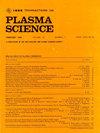The Distribution of Active Substances and the Bacterial Inactivation Effect Induced by a Helium Microplasma
IF 1.3
4区 物理与天体物理
Q3 PHYSICS, FLUIDS & PLASMAS
引用次数: 0
Abstract
Inactivation of bacteria by plasma is related to its active substances; the aim of this study is to investigate the impact of active substances’ spatial distribution on inactivation efficiency. In this study, a comparative analysis of the distribution and concentration of reactive oxygen and nitrogen species (RONSs) in the cross section of the plasma jet was conducted under different discharge voltages, working gas flow rates, and treatment distances. Then the impact of RONS distribution on the inactivation efficiency against Staphylococcus aureus (ATCC 25923) biofilm was analyzed. Experimental results demonstrated an influence of gas flow rates and treatment distances on RONS distribution. For instance, at the treatment distance of 3 mm, RONS distribution showed a solid circular shape at 0.4 standard liters per minute (SLM) and below, a double ring shape at 0.5 SLM, and a ring shape at 0.6 SLM. At 5 mm, the RONS distribution showed a solid circular shape at 0.8 SLM and below, a double ring shape at 0.9 SLM, and a ring shape at 0.9 SLM and above. The total redox concentration exhibited a positive correlation with the three physical parameters. Biofilm was treated for 100 s at a vertical position of approximately 3 mm. The inactivation of biofilm by the jet was slightly more efficient at 0.4 SLM (RONS was characterized by a low concentration of solid circular shape) compared to 0.8 SLM (high concentration of ring shape). Extending the treatment time to 300 s resulted in similar inactivation efficiency at 0.8 to 0.4 SLM.氦微等离子体诱导的活性物质分布和细菌灭活效果
等离子体对细菌的灭活与其活性物质有关;本研究旨在探讨活性物质的空间分布对灭活效率的影响。本研究对不同放电电压、工作气体流速和处理距离下等离子体射流截面上活性氧和氮物种(RONS)的分布和浓度进行了比较分析。然后分析了 RONS 分布对金黄色葡萄球菌(ATCC 25923)生物膜灭活效率的影响。实验结果表明,气体流速和处理距离对 RONS 分布有影响。例如,在处理距离为 3 毫米时,RONS 的分布在 0.4 标准升/分钟及以下时呈实心圆形,在 0.5 标准升/分钟时呈双环形,在 0.6 标准升/分钟时呈环形。在 5 毫米处,RONS 分布在 0.8 标准升/分钟及以下呈实心圆形,在 0.9 标准升/分钟呈双环形,在 0.9 标准升/分钟及以上呈环形。总氧化还原浓度与三个物理参数呈正相关。在约 3 毫米的垂直位置处理生物膜 100 秒。与 0.8 SLM(高浓度的环形)相比,0.4 SLM(RONS 的特征是低浓度的实心圆形)的喷射对生物膜的灭活效率略高。将处理时间延长至 300 秒后,0.8 SLM 和 0.4 SLM 的灭活效率相似。
本文章由计算机程序翻译,如有差异,请以英文原文为准。
求助全文
约1分钟内获得全文
求助全文
来源期刊

IEEE Transactions on Plasma Science
物理-物理:流体与等离子体
CiteScore
3.00
自引率
20.00%
发文量
538
审稿时长
3.8 months
期刊介绍:
The scope covers all aspects of the theory and application of plasma science. It includes the following areas: magnetohydrodynamics; thermionics and plasma diodes; basic plasma phenomena; gaseous electronics; microwave/plasma interaction; electron, ion, and plasma sources; space plasmas; intense electron and ion beams; laser-plasma interactions; plasma diagnostics; plasma chemistry and processing; solid-state plasmas; plasma heating; plasma for controlled fusion research; high energy density plasmas; industrial/commercial applications of plasma physics; plasma waves and instabilities; and high power microwave and submillimeter wave generation.
 求助内容:
求助内容: 应助结果提醒方式:
应助结果提醒方式:


